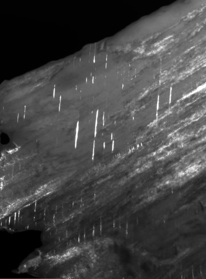CONTACT INFORMATION
| Phone: (216) 368-3868 |
| Fax: (216) 368-8932 |
| Email: heuer@case.edu |
Office:White 418, 10900 Euclid Ave, Cleveland, OH 44106-72074 |
EDUCATION
D Sc. in Physical Ceramics University of Leeds, England
Ph.D. in Applied Science University of Leeds, England
B.S. in Chemistry City College of New York |
ACTIVE RESEARCH
Paraequilibrium Carburization of Stainless Steels
Low temperature paraequilibrium carburization is being used to surface harden a variety of stainless steels. Hardened cases, 25-20 µm deep can be generated in industrially relevant times and result in materials with vastly improved wear, fatigue, and corrosion resistance.
Oxidation-induced Stresses in Ni-base Alloys
Oxidation-induced stresses in structural alloys, a long-standing problem, is far from understood. The high brilliance of synchrotron X-rays at the Advanced Photon Laboratory at ANL allows for in situ measurements of the evolution of such intrinsic stresses. |
 |
POTENTIAL IMPACT
The carburization research can be used for a wide variety of stainless steel components, inasmuch as the conformal carburization process is applied to finished components and entails no dimensional change. The oxidation-induced stress will provide the necessary underpinning to develop more oxidation-resistant Ni-base alloys.
SELECTED PUBLICATIONS
G.M. Michal, F. Ernst, H. Kahn, Y. Cao, F. Oba, N. Agarwal and A. H. Heuer, “Carbon supersaturation due to paraequilibrium carburization: Stainless steels with greatly improved mechanical propertire” Acta Mat.54 (6),1597-1606 (2006).
G. M. Michal, F. Ernst and A.H. Heuer, “Carbon paraequilibrium in austenitic stainless steel”, Met TransA 37A, 1819-1824 (2006).
A. Reddy, D. B. Hovis, B.Veal, A. Paulikas, A. Vlad, M. Rühle and A.H. Heuer, “The effect of surface orientation on oxidation-induced growth strains in single crystal NiAl: an in situ synchrotron study” Scripta Mat.54 1907-1912 (2006).
D.B.Hovis and A.H. Heuer, “Confocal photo-stimulated microscopy (CPSM)-residual stress measurements in Al2O3 using confocal microscopy”, Scripta Mat 53 (3) 347-349 (2005).
FIELDS
|